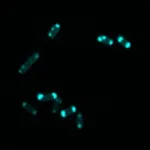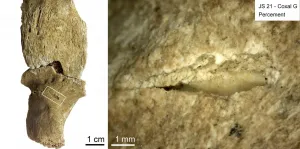(Press-News.org) AUSTIN, Texas -- In the perpetual arms races between bacteria and human-made antibiotics, there is a new tool to give human medicine the edge, in part by revealing bacterial weaknesses and potentially by leading to more targeted or new treatments for bacterial infections.
A research team led by scientists at The University of Texas at Austin has developed chemical probes to help identify an enzyme, produced by some types of E. coli and pneumococcal bacteria, known to break down several common types of antibiotics, making these bacteria dangerously resistant to treatment.
"In response to antibiotic treatment, bacteria have evolved various mechanisms to resist that treatment, and one of those is to make enzymes that basically chew up the antibiotics before they can do their job," said Emily Que, assistant professor of chemistry and one of the leading researchers on the team. "The type of tool we developed gives us critical information that could keep us one step ahead of deadly bacteria."
In a paper published online yesterday in the END
Fight against antibiotic-resistant bacteria has a glowing new weapon
2021-05-27
ELSE PRESS RELEASES FROM THIS DATE:
The robot smiled back
2021-05-27
New York, NY--May 27, 2021--While our facial expressions play a huge role in building trust, most robots still sport the blank and static visage of a professional poker player. With the increasing use of robots in locations where robots and humans need to work closely together, from nursing homes to warehouses and factories, the need for a more responsive, facially realistic robot is growing more urgent.
Long interested in the interactions between robots and humans, researchers in the Creative Machines Lab at Columbia Engineering have been working for five years to create EVA, a new autonomous robot with a soft and expressive ...
Archaeology: Prehistoric violence at Jebel Sahaba may not have been single event
2021-05-27
Reanalysis of the prehistoric cemetery Jebel Sahaba (Sudan), one of the earliest sites showing human warfare (13,400 years ago), suggests that hunter-fisher-gatherers engaged in repeated, smaller conflicts. The findings are published in Scientific Reports. Healed trauma on the skeletons found in the cemetery indicates that individuals fought and survived several violent assaults, rather than fighting in one fatal event as previously thought.
Isabelle Crevecoeur and colleagues reanalysed the skeletal remains of 61 individuals, who were originally ...
Icebergs push back
2021-05-27
Shortly before Jakobshavn Isbræ, a tidewater glacier in Greenland, calves massive chunks of ice into the ocean, there's a sudden change in the slushy collection of icebergs floating along the glacier's terminus, according to a new paper led by the Cooperative Institute for Research in Environmental Sciences (CIRES) at CU Boulder. The work, published in Nature Geoscience, shows that a relaxation in the thick aggregate of icebergs floating at the glacier-ocean boundary occurs up to an hour before calving events. This finding may help scientists better understand future sea-level rise scenarios and could also help ...
Jebel Sahaba: A succession of violence rather than a prehistoric war
2021-05-27
Since its discovery in the 1960s, the Jebel Sahaba cemetery (Nile Valley, Sudan), 13 millennia old, was considered to be one of the oldest testimonies to prehistoric warfare. However, scientists from the CNRS and the University of Toulouse - Jean Jaurès (1) have re-analysed the bones preserved in the British Museum (London) and re-evaluated their archaeological context. The results, published in Scientific Reports on May 27, 2021, show that it was not a single armed conflict but rather a succession of violent episodes, probably exacerbated by climate change.
Many individuals buried at Jebel Sahaba bear injuries, half ot them caused by projectiles, the points of which were found in the bones or the fill where the body was located. The ...
Association of tracheostomy with outcomes in patients with COVID-19 and SARS-CoV-2 transmission among health care workers
2021-05-27
What The Study Did: The findings of this systematic review and meta-analysis indicate that enhanced personal protective equipment is associated with low rates of SARS-CoV-2 transmission during tracheostomy.
Authors: Phillip Staibano, M.Sc., M.D., of McMaster University in Ontario, Canada, is the corresponding author.
To access the embargoed study: Visit our For The Media website at this link https://media.jamanetwork.com/
(doi:10.1001/jamaoto.2021.0930)
Editor's Note: The article includes conflict of interest disclosures. Please see the article for additional information, including other authors, author contributions and affiliations, conflict of interest and financial ...
Factors associated with racial/ethnic group-based medical mistrust, perspectives on COVID-19 vaccine
2021-05-27
What The Study Did: This survey study of adults living Michigan during the COVID-19 pandemic examines associations between race/ethnicity, medical mistrust within racial/ethnic groups and willingness to participate in COVID-19 vaccine trials or to receive a COVID-19 vaccine.
Authors: Hayley S. Thompson, Ph.D., of the Wayne State University School of Medicine in Detroit, is the corresponding author.
To access the embargoed study: Visit our For The Media website at this link https://media.jamanetwork.com/
(doi:10.1001/jamanetworkopen.2021.11629)
Editor's Note: The article includes conflict of interest and funding/support disclosures. Please see the article for additional information, including other authors, author contributions and affiliations, ...
Myocarditis in big ten athletes with recent SARS-CoV-2 infection
2021-05-27
What The Study Did: In this study of 1,597 Big Ten athletes who had comprehensive cardiac screening, including cardiac magnetic resonance (CMR) imaging, after COVID-19 infection, 37 athletes (2.3%) were diagnosed with clinical and subclinical myocarditis. Researchers report CMR screening increased detection of myocarditis, a leading cause of sudden death in competitive athletes.
Authors: Curt J.Daniels, M.D., and Saurabh Rajpal, M.B.B.S., M.D., of Ohio State University in Columbus, are the corresponding authors.
To access the embargoed study: Visit our For The Media website at this link https://media.jamanetwork.com/
(doi:10.1001/jamacardio.2021.2065)
Editor's ...
How metals work together to weaken hardy nitrogen-nitrogen bonds
2021-05-27
CAMBRIDGE, MA -- Nitrogen, an element that is essential for all living cells, makes up about 78 percent of Earth's atmosphere. However, most organisms cannot make use of this nitrogen until it is converted into ammonia. Until humans invented industrial processes for ammonia synthesis, almost all ammonia on the planet was generated by microbes using nitrogenases, the only enzymes that can break the nitrogen-nitrogen bond found in gaseous dinitrogen, or N2.
These enzymes contain clusters of metal and sulfur atoms that help perform this critical reaction, but the mechanism of how they do so is not well-understood. For the first time, MIT chemists have now determined the structure of a complex that forms when N2 binds to these clusters, and they discovered that the clusters are able to weaken ...
Roots of major depression revealed in all its genetic complexity
2021-05-27
A massive genome-wide association study (GWAS) of genetic and health records of 1.2 million people from four separate data banks has identified 178 gene variants linked to major depression, a disorder that will affect one of every five people during their lifetimes.
The results of the study, led by the U.S. Department of Veterans Affairs (V.A.) researchers at Yale University School of Medicine and University of California-San Diego (UCSD), may one day help identify people most at risk of depression and related psychiatric disorders and help doctors prescribe drugs best suited to treat the disorder.
The study was published May 27 in the journal Nature Neuroscience.
For the ...
Gene research on brassicas provides potential for making better crops
2021-05-27
The research - by the University of York - gives scientists a new tool that will support the development of new varieties.
The research led to scientists being able to develop an adaptable framework for describing gene content and order across all Brassica species.
Lead author, Professor Ian Bancroft, Chair of Plant Genomics at the Centre for Novel Agricultural Products (CNAP), at the Department of Biology said: "The research has helped us understand the trajectory of how genomes evolve in brassicas. We can use this new knowledge, for example, to accelerate the exchange of beneficial genes between Brassica species."
Brassica vegetables, such as broccoli, cabbage, kale, pak choi and swede, along with brassica oil crops such as ...



